
The Genus Fuchsia
Section Schufia
(two species)
The two arborescent species of this section are found in the barranca vegetation of the pine-oak forests or the evergreen cloud forests of the Sierra Madre Occidental in Mexico, from Durango to Oaxaca and through the Trans-Mexican Volcanic Belt to Puebla and Veracruz, south in Central America to Panama, at elevations from 800 to 3,000 meters. Their leaves are opposite or whorled in sets of three or four. The numerous flowers are held in terminal panicles, with floral tubes less than eight millimeters long, and have smooth to lobed nectaries The spreading to reflexed sepals are colored a lustrous reddish purple and the petals are lavender. The stamens occur in two unequal series with yellow pollen. The fruit contains between 50 and 100 seeds. The two species in this group are often confused with each other so it should be noted that F. arborescens generally forms a larger shrub or small tree, with entire leaf margins, and F. paniculata generally remains smaller and has leaf margins that are minutely to coarsely serrate.
The name applied this to section first appeared in 1835 when the French-Alsatian botanist, Édouard Spach (1801-1879), thinking that Fuchsia arborescens's lilac-like panicles made it quite unlikely that it could be closely related to Fuchsia, created the new monospecific genus of Schufia to hold it. The Austrian botanist, Stephan Endlicher (1804-1849), saw the proper connection and put Schufia arborescens back into Fuchsia in 1840. The name later was revived for the section. In origin, Schufia is simply an anagram of Fuchsia. See ➤ Schuffled Schufia on the Urban Fuchsia + Blog.
Name: Fuchsia sect. Schufia (Spach) Munz, 1943.
Typus: F. arborescens Sims
Synonyms
Basionym
Schufia Spach, Hist. Nat. Veg. 4: 411. 1835.
Section Schufia
(two species)
The two arborescent species of this section are found in the barranca vegetation of the pine-oak forests or the evergreen cloud forests of the Sierra Madre Occidental in Mexico, from Durango to Oaxaca and through the Trans-Mexican Volcanic Belt to Puebla and Veracruz, south in Central America to Panama, at elevations from 800 to 3,000 meters. Their leaves are opposite or whorled in sets of three or four. The numerous flowers are held in terminal panicles, with floral tubes less than eight millimeters long, and have smooth to lobed nectaries The spreading to reflexed sepals are colored a lustrous reddish purple and the petals are lavender. The stamens occur in two unequal series with yellow pollen. The fruit contains between 50 and 100 seeds. The two species in this group are often confused with each other so it should be noted that F. arborescens generally forms a larger shrub or small tree, with entire leaf margins, and F. paniculata generally remains smaller and has leaf margins that are minutely to coarsely serrate.
The name applied this to section first appeared in 1835 when the French-Alsatian botanist, Édouard Spach (1801-1879), thinking that Fuchsia arborescens's lilac-like panicles made it quite unlikely that it could be closely related to Fuchsia, created the new monospecific genus of Schufia to hold it. The Austrian botanist, Stephan Endlicher (1804-1849), saw the proper connection and put Schufia arborescens back into Fuchsia in 1840. The name later was revived for the section. In origin, Schufia is simply an anagram of Fuchsia. See ➤ Schuffled Schufia on the Urban Fuchsia + Blog.
Name: Fuchsia sect. Schufia (Spach) Munz, 1943.
Typus: F. arborescens Sims
Synonyms
Basionym
Schufia Spach, Hist. Nat. Veg. 4: 411. 1835.
F. arborescens Sims
Mexico. In barranca vegetation, or moist ravines, of pine-oak forest in the Sierra Madre Occidental from Durango to Oaxaca and through the Trans-Mexican Volcanic Belt to Veracruz and then into northern Oaxaca at elevations from 1,750 to 2,500 meters.
Flowering is mostly in the dry season, from December to May, but also well into the wet season.
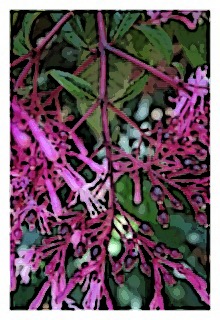
 Habit—Hermaphroditic. Erect, woody shrubs or small trees three to four meters tall, mostly glabrous throughout. Branchlets ascending, 10 to 40 cm long, 2 to 5 mm thick, subtriangular to quadrangular; older branches and main trunk 5 to 25 cm thick.
Habit—Hermaphroditic. Erect, woody shrubs or small trees three to four meters tall, mostly glabrous throughout. Branchlets ascending, 10 to 40 cm long, 2 to 5 mm thick, subtriangular to quadrangular; older branches and main trunk 5 to 25 cm thick.
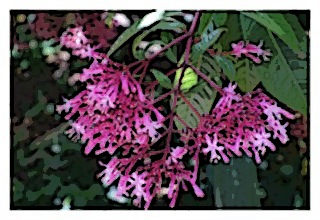

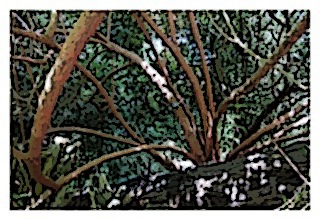
Leaves—Opposite or three to four-verticillate, firmly membranous to subcoriaceous, smooth, elliptic to oblanceolate or obovate, acute to narrowly cuneate at base, acute to acuminate at apex, 10 to 21 cm long, 4 to 8 cm wide, deep lustrous green above, paler below; margin entire; petiole 12 to 30 mm long; stipules broadly triangular, occasionally connate, 0.8 to 1.2 mm long, 1.0 to 1.5 mm wide, deciduous.
Flowers—Erect and numerous in terminal, di- to trichotomously branched panicles, 10 to 25 cm long, 9 to 20 cm wide, pedicels erect, slender, 9 to 18 mm long, floral tube subcylindric to obconic, 3.5 to 6 mm long, 1 to 1.5 mm wide at base, more-o-rless enlarged around nectary, 24 mm wide at rim, usually glabrous inside and outside, flowers widened toward apex in bud, sepals oblong to lanceolate, acuminate, 4 to 11 mm long, 1.5 to 2.5 mm wide, spreading to reflexed at anthesis, tube and sepals rose-purple, petals lavender, lance-oblong to elliptic, 4-9 mm long, 1.5 to 3 mm wide, broadly acute at base, acute at apex, erect to spreading, nectary a smooth and irregularly lobed ring 1 to 1.6 mm high adnate to the base of the tube, antisepalous filaments 5 to 12 mm long, antipetalous ones 3 to 9 mm long, pink-purple, anthers oblong, 1.5 to 2.3 mm long, 1 to 1.5 mm thick, style 9 to 17 mm long, glabrous, pink, the stigma always exserted above the anthers, 1.5 to 3 mm wide, with four blunt lobes 1 to 2 mm long, lavender.
Fruit: The berry is subglobose, 8 to 12 mm long, 7 to 10 mm thick, and purple with a glaucous, waxy bloom when ripe.
Seeds: 1 to 1.5 mm long and 0.5 to 0.8 mm thick.
Chromosomes: Gametic chromosome number n = 11.
Authors—John Sims 1825, Berry & Breedlove 1996.
Original publication—Bot. Mag. 53: t. 2620 1826.
Synonyms—F. arborescens Sims; F. arborea Sessé & Moc.; Schufia arborescens (Sims) Spach; F. arborescens forma parva Munz; F. arborescens forma tenuis Munz; F. arborescens var. megalantha Donn. Sm.; F. arborescens var. arborescens; F. arborescens var. typica Munz.
Herbarium Specimens—Field Museum 1, Field Museum 2, Field Museum 3; Smithsonian.
Mexico. In barranca vegetation, or moist ravines, of pine-oak forest in the Sierra Madre Occidental from Durango to Oaxaca and through the Trans-Mexican Volcanic Belt to Veracruz and then into northern Oaxaca at elevations from 1,750 to 2,500 meters.
Flowering is mostly in the dry season, from December to May, but also well into the wet season.





Leaves—Opposite or three to four-verticillate, firmly membranous to subcoriaceous, smooth, elliptic to oblanceolate or obovate, acute to narrowly cuneate at base, acute to acuminate at apex, 10 to 21 cm long, 4 to 8 cm wide, deep lustrous green above, paler below; margin entire; petiole 12 to 30 mm long; stipules broadly triangular, occasionally connate, 0.8 to 1.2 mm long, 1.0 to 1.5 mm wide, deciduous.
Flowers—Erect and numerous in terminal, di- to trichotomously branched panicles, 10 to 25 cm long, 9 to 20 cm wide, pedicels erect, slender, 9 to 18 mm long, floral tube subcylindric to obconic, 3.5 to 6 mm long, 1 to 1.5 mm wide at base, more-o-rless enlarged around nectary, 24 mm wide at rim, usually glabrous inside and outside, flowers widened toward apex in bud, sepals oblong to lanceolate, acuminate, 4 to 11 mm long, 1.5 to 2.5 mm wide, spreading to reflexed at anthesis, tube and sepals rose-purple, petals lavender, lance-oblong to elliptic, 4-9 mm long, 1.5 to 3 mm wide, broadly acute at base, acute at apex, erect to spreading, nectary a smooth and irregularly lobed ring 1 to 1.6 mm high adnate to the base of the tube, antisepalous filaments 5 to 12 mm long, antipetalous ones 3 to 9 mm long, pink-purple, anthers oblong, 1.5 to 2.3 mm long, 1 to 1.5 mm thick, style 9 to 17 mm long, glabrous, pink, the stigma always exserted above the anthers, 1.5 to 3 mm wide, with four blunt lobes 1 to 2 mm long, lavender.
Fruit: The berry is subglobose, 8 to 12 mm long, 7 to 10 mm thick, and purple with a glaucous, waxy bloom when ripe.
Seeds: 1 to 1.5 mm long and 0.5 to 0.8 mm thick.
Chromosomes: Gametic chromosome number n = 11.
Authors—John Sims 1825, Berry & Breedlove 1996.
Original publication—Bot. Mag. 53: t. 2620 1826.
Synonyms—F. arborescens Sims; F. arborea Sessé & Moc.; Schufia arborescens (Sims) Spach; F. arborescens forma parva Munz; F. arborescens forma tenuis Munz; F. arborescens var. megalantha Donn. Sm.; F. arborescens var. arborescens; F. arborescens var. typica Munz.
Herbarium Specimens—Field Museum 1, Field Museum 2, Field Museum 3; Smithsonian.
F. paniculata Lindl. (2 subspecies)
Authors—Lindley 1856.
Original publication—Gard. Chron. 1856: 301 1856.
F. paniculata subsp. mixensis P.E.Berry & Breedlove
Mexico. Known only from central Oaxaca State, Mexico in the Mixe and Ixtlan Districts in dense montane rainforest and mixed oak-conifer forest at elevations from 1,700 to 2,500 meters.
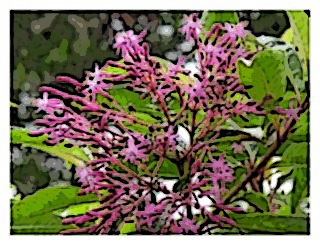 Habit—Erect shrub 2.5 to four meters tall with branchlets ascending 5 to 30 cm long, finely pubescent with hairs 0.2 to 0.4 mm long.
Habit—Erect shrub 2.5 to four meters tall with branchlets ascending 5 to 30 cm long, finely pubescent with hairs 0.2 to 0.4 mm long.
Leaves—Opposite, membranous. the blade elliptic, 11 to 25 cm long, 4 to 10 cm wide, puberulent on the lower surface along the veins, becoming glabrescent on the upper surface but short hairs often present along the veins secondary veins 14 to 18 on either side of the midvein, apex acute to subacuminate, base acute to attenuate, margin gland-denticulate, petiole 10 to 25 mm long, puberulent, stipules narrowly triangular, dark brown, 0.3 to 0.7 rnm wide, 1.0 to 1.5 mm long, crassate. soon deciduous.
Flowers—Gynodioecious. Erect and numerous in terminal di- to trichotomously branched panicles, 10 to 20 cm long by 10 to 15 cm wide, narrowly leaflike, quickly deciduous bracteoles 1 to 3 mm long present at branching points of the panicle. Perfect Flowers, pedicels slender, 15 to 20 mm long, finely pubescent, ovary oblong, puberulent, 2 to 3 mm long, buds noticeably wider at the tip than below, 4 to 5 mm wide at the apex before opening, floral tube cylindric-conical, reddish pink to magenta, sparsely puberulent to subglabrous externally, 4 to 5 mm long at anthesis, 2 to 2.5 mm wide at the rim, 1 to 1.5 mm wide at the base, sepals narrowly oblong, 8 to 10 mm long, 1.5 to 2.5 mm wide, soon becoming reflexed back against the floral tube. the apex acute, petals obovate, pink-lavender, 4 4 mm long, 2 to 4.5 mm wide, nectary 1.2 to 1.5 mm high, slightly lobed, adnate to the bottom of the floral tube, filaments lavender, 7 to 11 mm long, anthers oblong, about 2 by 1 mm, style 14 to 18 mm long, exserted 10 to 13 mm beyond the rim of the tube, stigma capitate, +four-angled, 1.5 to 2 mm wide, fruit subglobose, 5 to 7 mm in diameter, mature seeds not seen. Female flowers, similar to the perfect ones except in the following characters, pedicels 9 to 14 mm long, floral tube cylindrical, 3.5 to 4.5 mm long, about. 2 mm wide at the rim, 1 to 1.5 mm wide at the base, sepals 6 to 7 mm long, about 1.5 mm wide at the base, petals 3.5 to 4.5 mm long, 2 to 2.5 mm wide, filaments 3 to 4 mm long, sterile anthers oblong, about 1 mm long, nectary about 1.5 mm high, style 13 about 14 mm long, stigma square-capitate, with four noticeable lobes, 2 to 2.5 mm wide, exserted 8 to 9 mm beyond the rim of the tube.
Berries—
Seeds—
Chromosomes—
Authors—Berry & Breedlove 1996.
Original publication—
Synonyms—None.
Herbarium Specimens—
F. paniculata subsp. paniculata (Lindl.) P.E.Berry & Breedlove
Mexico to Panama. Frequent in moist oak-pine and evergreen cloud forest from Veracruz, Mexico south to central Panama and, north of the Isthmus of Tehuantepec, it occurs only on the wet Caribbean facing-slopes in Puebla, Veracruz, and Oaxaca States at elevations from (800 to) 1,200 to 3,000 meters.
F. panuculata subsp. paniculata flowers throughout the year.
Habit—Erect woody shrubs or small trees three to eight meters tall, usually glabrous. Branchlets ascending, 10 to 40 cm long, to 5 m thick, subtriangular to quadrangular. Older branches and main trunk 2 to 15 cm thick.
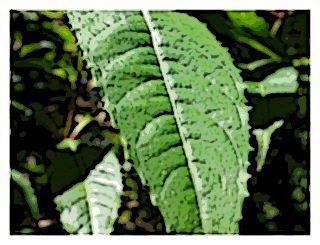 Leaves—Opposite or 3-4-verticillate, subcoriaceous, elliptic to oblanceolate, acute to narrowly cuneate at base, acute to acuminate at apex, 5-15.5 cm long, 2-5.5 cm wide, deep lustrous green above, paler below; margin minutely to coarsely serrate; petiole 8-26 mm long; stipules triangular, often connate, 0.8-1.2 mm long, 0.7-1.5 mm wide, deciduous.
Leaves—Opposite or 3-4-verticillate, subcoriaceous, elliptic to oblanceolate, acute to narrowly cuneate at base, acute to acuminate at apex, 5-15.5 cm long, 2-5.5 cm wide, deep lustrous green above, paler below; margin minutely to coarsely serrate; petiole 8-26 mm long; stipules triangular, often connate, 0.8-1.2 mm long, 0.7-1.5 mm wide, deciduous.
Flowers—Gynodioecious or subdioecious. Flowers erect and numerous in terminal, di- to trichotomously branched panicles, 10 to 14 cm long, 9 to 12 cm wide, narrowed towards the apex. Perfect flowers, pedicels slender, 8 to 12 mm long, floral tube cylindric to subobconic, 4 to 8 mm long, 1 to 2 mm wide at base, 1.5 to 3 mm wide at the rim, often pilose within, sepals lanceolate, 5 to 10 mm long, 1.1 to 2.5 mm wide, spreading to reflexed at anthesis, tube and sepals rose-purple, petals lavender, lanceolate to elliptic, 4 to 10 mm long, 1.1 to 3.5 mm wide, acute at both ends, erect to spreading, nectary smooth to irregularly lobed ring 1.3 to 2 mm high adnate to the base of the tube, antisepalous filaments 4 to 13 mm long, antipetalous ones 2 to 11 mm long, pink, anthers broadly ovoid to reniform, 0.8 to 1.6 (to 2) mm long, 0.7 to1.4 mm thick, style sparsely pilose, either exserted beyond anthers with a shortly quadrilobed stigma or included below the anthers and the stigma strongly reduced, lavender. Pistillate flowers, similar to the perfect ones except in the following characters, floral tube smaller, 3 to 5.5 mm long, 0.7 to 1.7 mm wide at base, 1.5 to 2.2 mm wide at rim, sepals 3.5 to 7 mm long, 0.7 to 1.3 mm wide, petals 2.3 to 4.5 mm long, 0.6- to .3 mm wide, nectary 0.8 to 1.4 mm high, antisepalous filaments 1.5 to 4.9 mm long, antipetalous ones 1.0 to 3.9 mm long, anthers abortive, 0.4 to 0.8 mm long, 0.2 to 0.6 mm thick, style stout, to 11 mm long, the.stigma well exserted above the stamens, quadri-lobed, lobes 0.6 to 1.9 mm long.
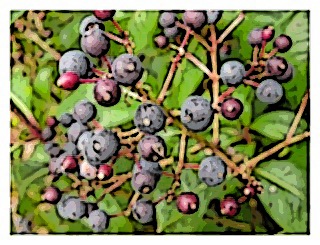
Fruit—The berry is subglobose, 4 to 9 mm long, 4 to 7 mm thick, and purple with a glaucous, waxy bloom.
Seeds—1 to 1.4 mm long and 0.5 to 0.8 mm thick.
Chromosomes—Gametic chromosome number n = 11.
Authors—Berry & Breedlove 1996.
Original publication—Gard. Chron. 1856: 301 1856.
Synonyms—F. paniculata Lindl.; F. liebmannii H. Lév.; F. arborea Sessé & Moc.; F. hamellioides Moc. & Sesse ex G. Don; F. syringiflora (Lem.) Carrière; Schufia arborescens (Sims) Spach; F. arborescens fo. parva Munz; F. arborescens fo. tenuis Munz; F. arborescens var. megalantha Donn. Sm.; F. arborescens var. syringiflora Lem.
Herbarium Specimens—Kew.
Authors—Lindley 1856.
Original publication—Gard. Chron. 1856: 301 1856.
F. paniculata subsp. mixensis P.E.Berry & Breedlove
Mexico. Known only from central Oaxaca State, Mexico in the Mixe and Ixtlan Districts in dense montane rainforest and mixed oak-conifer forest at elevations from 1,700 to 2,500 meters.

Leaves—Opposite, membranous. the blade elliptic, 11 to 25 cm long, 4 to 10 cm wide, puberulent on the lower surface along the veins, becoming glabrescent on the upper surface but short hairs often present along the veins secondary veins 14 to 18 on either side of the midvein, apex acute to subacuminate, base acute to attenuate, margin gland-denticulate, petiole 10 to 25 mm long, puberulent, stipules narrowly triangular, dark brown, 0.3 to 0.7 rnm wide, 1.0 to 1.5 mm long, crassate. soon deciduous.
Flowers—Gynodioecious. Erect and numerous in terminal di- to trichotomously branched panicles, 10 to 20 cm long by 10 to 15 cm wide, narrowly leaflike, quickly deciduous bracteoles 1 to 3 mm long present at branching points of the panicle. Perfect Flowers, pedicels slender, 15 to 20 mm long, finely pubescent, ovary oblong, puberulent, 2 to 3 mm long, buds noticeably wider at the tip than below, 4 to 5 mm wide at the apex before opening, floral tube cylindric-conical, reddish pink to magenta, sparsely puberulent to subglabrous externally, 4 to 5 mm long at anthesis, 2 to 2.5 mm wide at the rim, 1 to 1.5 mm wide at the base, sepals narrowly oblong, 8 to 10 mm long, 1.5 to 2.5 mm wide, soon becoming reflexed back against the floral tube. the apex acute, petals obovate, pink-lavender, 4 4 mm long, 2 to 4.5 mm wide, nectary 1.2 to 1.5 mm high, slightly lobed, adnate to the bottom of the floral tube, filaments lavender, 7 to 11 mm long, anthers oblong, about 2 by 1 mm, style 14 to 18 mm long, exserted 10 to 13 mm beyond the rim of the tube, stigma capitate, +four-angled, 1.5 to 2 mm wide, fruit subglobose, 5 to 7 mm in diameter, mature seeds not seen. Female flowers, similar to the perfect ones except in the following characters, pedicels 9 to 14 mm long, floral tube cylindrical, 3.5 to 4.5 mm long, about. 2 mm wide at the rim, 1 to 1.5 mm wide at the base, sepals 6 to 7 mm long, about 1.5 mm wide at the base, petals 3.5 to 4.5 mm long, 2 to 2.5 mm wide, filaments 3 to 4 mm long, sterile anthers oblong, about 1 mm long, nectary about 1.5 mm high, style 13 about 14 mm long, stigma square-capitate, with four noticeable lobes, 2 to 2.5 mm wide, exserted 8 to 9 mm beyond the rim of the tube.
Berries—
Seeds—
Chromosomes—
Authors—Berry & Breedlove 1996.
Original publication—
Synonyms—None.
Herbarium Specimens—
F. paniculata subsp. paniculata (Lindl.) P.E.Berry & Breedlove
Mexico to Panama. Frequent in moist oak-pine and evergreen cloud forest from Veracruz, Mexico south to central Panama and, north of the Isthmus of Tehuantepec, it occurs only on the wet Caribbean facing-slopes in Puebla, Veracruz, and Oaxaca States at elevations from (800 to) 1,200 to 3,000 meters.
F. panuculata subsp. paniculata flowers throughout the year.
Habit—Erect woody shrubs or small trees three to eight meters tall, usually glabrous. Branchlets ascending, 10 to 40 cm long, to 5 m thick, subtriangular to quadrangular. Older branches and main trunk 2 to 15 cm thick.

Flowers—Gynodioecious or subdioecious. Flowers erect and numerous in terminal, di- to trichotomously branched panicles, 10 to 14 cm long, 9 to 12 cm wide, narrowed towards the apex. Perfect flowers, pedicels slender, 8 to 12 mm long, floral tube cylindric to subobconic, 4 to 8 mm long, 1 to 2 mm wide at base, 1.5 to 3 mm wide at the rim, often pilose within, sepals lanceolate, 5 to 10 mm long, 1.1 to 2.5 mm wide, spreading to reflexed at anthesis, tube and sepals rose-purple, petals lavender, lanceolate to elliptic, 4 to 10 mm long, 1.1 to 3.5 mm wide, acute at both ends, erect to spreading, nectary smooth to irregularly lobed ring 1.3 to 2 mm high adnate to the base of the tube, antisepalous filaments 4 to 13 mm long, antipetalous ones 2 to 11 mm long, pink, anthers broadly ovoid to reniform, 0.8 to 1.6 (to 2) mm long, 0.7 to1.4 mm thick, style sparsely pilose, either exserted beyond anthers with a shortly quadrilobed stigma or included below the anthers and the stigma strongly reduced, lavender. Pistillate flowers, similar to the perfect ones except in the following characters, floral tube smaller, 3 to 5.5 mm long, 0.7 to 1.7 mm wide at base, 1.5 to 2.2 mm wide at rim, sepals 3.5 to 7 mm long, 0.7 to 1.3 mm wide, petals 2.3 to 4.5 mm long, 0.6- to .3 mm wide, nectary 0.8 to 1.4 mm high, antisepalous filaments 1.5 to 4.9 mm long, antipetalous ones 1.0 to 3.9 mm long, anthers abortive, 0.4 to 0.8 mm long, 0.2 to 0.6 mm thick, style stout, to 11 mm long, the.stigma well exserted above the stamens, quadri-lobed, lobes 0.6 to 1.9 mm long.

Fruit—The berry is subglobose, 4 to 9 mm long, 4 to 7 mm thick, and purple with a glaucous, waxy bloom.
Seeds—1 to 1.4 mm long and 0.5 to 0.8 mm thick.
Chromosomes—Gametic chromosome number n = 11.
Authors—Berry & Breedlove 1996.
Original publication—Gard. Chron. 1856: 301 1856.
Synonyms—F. paniculata Lindl.; F. liebmannii H. Lév.; F. arborea Sessé & Moc.; F. hamellioides Moc. & Sesse ex G. Don; F. syringiflora (Lem.) Carrière; Schufia arborescens (Sims) Spach; F. arborescens fo. parva Munz; F. arborescens fo. tenuis Munz; F. arborescens var. megalantha Donn. Sm.; F. arborescens var. syringiflora Lem.
Herbarium Specimens—Kew.